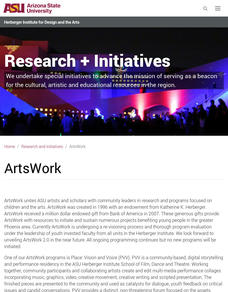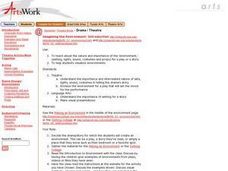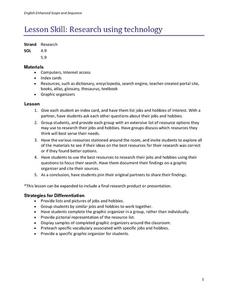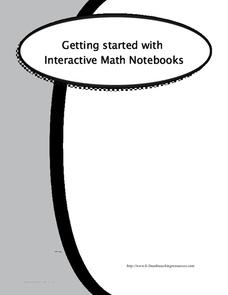Curated OER
Creating Plays from Children's Stories
Students explain how individual elements (e.g., plot, theme, character, conflict, etc.) comprise the structure of a play. They write an original one-act play with developed characters, specific setting, conflict, and resolution.
Curated OER
Collaborative Choreography, Contrasting Emotions
Students demonstrate choreographic principles, processes, and structures.
Curated OER
Imagining the Environment: Introduction
Students examine the importance of the environment including the setting, lights, sound, costumes, and props for a play or story. They visualize the appropriate environments and practice applying the techniques.
Curated OER
Making a Dance Involving Balance
Students make choices about dance elements and organize them in expressive ways. They plan and present dance works for a familiar audience. They identify dance elements in their and classmates work.
Curated OER
Historical Moments
Here is a lesson designed to be an ongoing task for the entire year. Each day of the week, learners must perform research to answer a simple historical question. This particular lesson covers the month of April, but the template...
Curated OER
Color Theory & Using Layers
Students investigate the color wheel theory and incorporate it into simple sketches on their handheld. The importance of the use of layering and the difference between primary, secondary, and tertiary colors is presented in this lesson.
Curated OER
Warhol and Collaboration
Young scholars view images of Warhol/Basquiat collaboration and discuss them using the questions listed in the lesson. They work in groups to choose a theme or topic relating to American culture and discuss ideas about symbols that could...
Curated OER
Compare Time
In this estimating time worksheet, 2nd graders solve 6 problems in which the time it takes to perform a specific task is estimated. Students choose an estimate from two answers.
Curated OER
Photo/Mat Weaving
Students explore the art of mat weaving. In this tapestry lesson, students create maps with paper or photographs. Students understand age appropriate skills and technique of map weaving. Students learn the cultural aspects of map weaving.
Curated OER
Furniture Defined
Young scholars dissect and evaluate traditional definitions of furniture styles. In this furniture characteristics lesson, student learn to classify different styles and types of furniture. Students create furniture sketches.
Curated OER
Don't Know Much About Hoyt
Hoyt Axton is a great artist, but he is often overlooked. Use this quiz to test your students' knowledge of Axton. There are 10 multiple-choice questions on this worksheet. Note: You can print this out, or have your class take the quiz...
Curated OER
Research Using Technology
Pupils receive an index card, and they write down jobs and hobbies that interest them. Then, they get together in groups and are assigned the task of researching the jobs and hobbies that are of the most interest to the entire group....
101 Questions
The Ticket Roll
This is your ticket to understanding estimation. Scholars estimate the number of tickets on a ticket roll. To perform the task, they use pictures and given dimensions of a ticket roll and of a single ticket and apply concepts of area and...
24x7 Digital
TeachMe: 1st Grade
Let your eager learners practice their basic arithmetic and spelling skills with this fun interactive resource! For any primary grade teacher with access to an Apple mobile device, this is a must-have application.
Curated OER
Getting Started with Interactive Math Notebooks
Set young mathematicians up for success with this interactive math notebook. Including a list of rules and expectations for using the notebooks, as well as templates for a creating a cover page and table of contents, this resource...
iCivics
Do I Have a Right? Bill of Rights Edition
In an online engaging and animated game, pupils role play as lawyers charged with protecting rights found in amendments to the United States Constitution. As they choose appropriate amendments to match the right that has been violated,...
US Department of Education
A Close Reading of Lincoln’s Gettysburg Address
Abraham Lincoln's Gettysburg Address provides the text for a series of close reading exercises that model for instructors how carefully crafted guiding questions can help readers think critically about what they read, thus developing...
IPA Productions
A Christmas Carol - The Story
Thirty-six pages familiarize scholars with the story and vocabulary of A Christmas Carol by Charles Dickens. After reading and listening to an abbreviated version of the holiday tale learners show what they know about the sequence of...
Curated OER
You Be The Judge: Olympics, Winter Sports, Figure Skating, Math, Statistics, Technology
Students design a score sheet for use when watching a figure skating performance. They use spreadsheet software and research information obtained on the Internet to create their score sheets.
Curated OER
Good Vibrations: Sound, Acoustics, Science, Sports Arenas, Olympics
Students perform a series of tasks that integrate hands-on inquiry-based activities with the Internet to explore sound and acoustics. They develop an acoustics Web page to show what they have learned.
Curated OER
Showtime Jobs
Students plan and present a play or puppet show. In this artistic lesson, students practice organizational and communication skills to put on a performance. The task should focus on the many jobs that take place "behind the scenes."
Curated OER
A Picture Is Worth A Thousand Words
Students examine the cultural and historical significance of certain artists. They use the internet to perform research and prepare a report of analysis of artistic works looking for cultural influences. Students also tie in the...
Curated OER
Pathways to the Future
Students draw a pathway and create a movement phrase along that same path using specific movement vocabulary. The phrases are performed in class and rubrics are used for assessment. Meets State standards for the arts.
Curated OER
Geometric Glances
Second graders locate, comprehend, interpret, evaluate, maintain, and apply information, concepts, and ideas found in literature, the arts, symbols, recordings, video and other graphic displays, and computer files in order to perform...
Other popular searches
- Algebra Performance Task
- Equations Performance Task
- Culminating Performance Task
- Performance Tasks Geometry
- Geometry Performance Task
- Cells Performance Task
- Performance Task Math
- Math Performance Tasks
- Performance Tasks for Math
- Exponent Performance Task
- Performance Task Assessment
- Science Performance Tasks

























